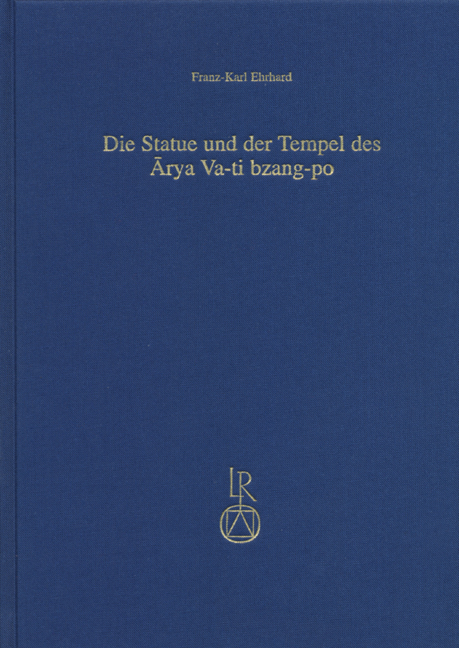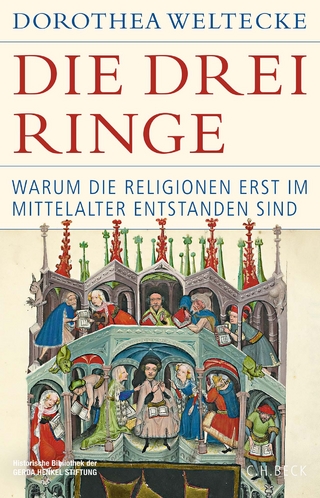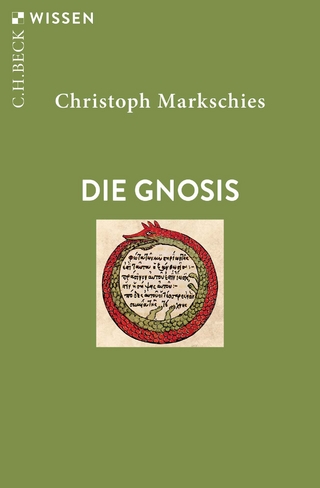
Die Statue und der Tempel des Arya Va-ti bzang-po
Reichert, L (Verlag)
978-3-89500-306-6 (ISBN)
Die Region von Mang-yul sKyid-rong im südwestlichen Tibet hat als Sitz der Statue und des Tempels des Arya Va-ti bzang-po eine besondere Bedeutung für die Welt des tibetischen Buddhismus. Die Statue zählt zu den so genannten "Brüdern Avalokitesvara" und soll bereits im 7. Jahrhundert von Nepal nach Tibet gelangt sein. Der Legende nach geht dieses Ereignis zurück auf das Wirken des Srong-btsan sgam-po, des ersten buddhistischen König Tibets; er soll ebenfalls den Bau des Tempels an der Grenze seines Reiches veranlasst haben. Die Rolle des Heiligtums für die Reisen tibetischer Gelehrter und Übersetzer kann aus historischen Quellen vielfach belegt werden, aber erst durch das literarische Genre von Pilgerführern ist es möglich, eine vollständige Beschreibung des wechselhaften Schicksals der Statue und des Tempels zu erhalten.
Die vorliegende Studie bietet eine annotierte Übersetzung eines solchen Pilgerführers, der in den Werken des Brag-dkar rta-so sPrul-sku Chos-kyi dbang-phyug (1775 bis 1837) zu finden ist. Der religiöse Einfluss dieses Lehrers der rNying-ma-pa- und 'Brug-pa bKa'-brgyud-pa-Überlieferungen war nicht nur auf Mang-yul sKyid-grong beschränkt, sondern man findet heute noch die Spuren seiner Lehrtraditionen in den Tälern des tibetischen Himalaya. Neben der Textedition dieses als Manuskript erhaltenen Werkes werden außerdem zwei als Blockdrucke erhaltene Texte zu der Statue und dem Tempel des Arya Va-ti bzang-po vorgestellt und textkritisch ediert; diese Werke stammen aus dem 16. Jahrhundert und können als die ältesten xylographierten Pilgerführer des tibetischen Kulturraumes bezeichnet werden.
Das Anliegen der Arbeit ist es, die religiöse Geographie einer Region zu beschreiben, die im kulturellen Gedächtnis der Tibeter einen zentralen Platz einnimmt und die als wichtiger Verbindungskorridor zwischen Tibet und dem Süden fungierte. Es kann gezeigt werden, wie sich eine religiöse Landschaft durch die jahrhundertlange Verehrung des Bodhisattvas des "Großen Mitgefühl" konstituierte.
Unter den erstmals für die Tibetologie und verwandte Disziplinen zugänglich gemachten Texteditionen finden sich weiterhin zwei Sammlungen von Hymnen an den Arya Va-ti bzang-po, die Lobpreise für das Standbild aus der Feder verschiedener Vertreter der Inkarnationsreihe des Dalai Lamas enthalten und die Popularität der Statue bei Vertretern der dGa'-ldan pho-brang-Regierung dokumentieren. Eine tibetische Karte, verschiedene Abbildungen, ein Faksimile des Pilgerführers aus dem 19. Jahrhundert sowie der komplette Überblick zum Aufbau der Gesammelten Werke des Brag-dkar rta-so sPrul-sku Chos-kyi dbang-phyug runden die Gesamtdarstellung ab.
Franz-Karl Ehrhard studierte Tibetologie, Indologie und Ethnologie an der Universität Hamburg. Promotion 1987. Von 1988 bis 1993 Leiter des Nepal Research Centre und des Nepal-German Manuscript Preservation Project in Kathmandu (Nepal) und von 1993 bis 1998 Mitglied des DFG-Schwerpunktprogrammes “Staatenbildung und Siedlungsprozesse im tibetischen Himalaya” (Universität Münster). 1998 Habilitation an der Universität Hamburg. Von 1998 bis 2003 Research Fellow am Lumbini International Research Institute in Lumbini (Nepal). Gastprofessuren in Wien und Harvard. Seit 2003 Professor für Tibetologie und Buddhismuskunde an der Universität München. Forschungsschwerpunkte: Literarische Traditionen des tibetischen Buddhismus, Himalayastudien, Manuskript- und Blockdruckkulturen Tibets.
"The impressive monograph under review, which is the author's "Habilitation" thesis, represents an important coniribution to the history and geography of Tibetan Buddhism. lt focuses on an important aspect of Nepalese and Tibetan eulture: the eult of the Statuen of the Avalokitesvara brothers which miraculously manifested from a sandalwood tree near the Indian-Nepalese border at the time of the first Tibetan Dharma king Srong btsan sgam po (d. A.D. 649), and were then taken each to a different place in Nepal and Tibet (varying according to tradition), one of them being the Tibetan border town of sKyid grong, where Arya Va ti bzang po (this the name of the naturally arisen statue of one particular form of Avalokitesvara, namely a standing Padmapani Lokesvara) found a home in the 'Phags pa Iha khang (i.c., the "Temple of the Noble [Va ti bzang po]"). This myth not only contributed considerably to the process of projecting the Tantric version of Mahayana Buddhism from India and Nepal onto Tibet, but also played an important role in the forming of a new centralized Tibetan state, with its ruler figuring as an emanation of Avalokitesvara.
The work under review centres around a rare pilgrimage guide to the statue of Arya Va ti bzang po and the remple 'Phags pa Iha khang of sKyid grong written by an influential author of the Nyingma and Kagyu schools, Brag dkar rta so sPrul sku Chos kyi dbang phyug (1775-1837). The full Tibetan title of the text is 'Phags mchog thugs rje chen po rang byung va ti bzang po'i rnam par thar pa ngo mtshar rmad du byung ba'i gtam dad pa'i nyin byed phyogs brgyar 'dren pa'i rta ljang zhes bya ba bzhugs so, in English: "A biography - [and] the astonishing story - of Va ti bzang po, the most noble Mahakarunika, who arose from himself - The emerald-green horse which pulls the sun of faith in a hundred directions." It is contained in Chos kyi dbang phyug's Collected Works, which Ehrhard microfilmed in the library of the learned master and lama sLob dpon 'Gyur med in the high mountain village of Sama Gaon during an expedition to Nubri in Nepal's Gorkha district (NGMPP reel nos. L 380/5 - 381/1, 56 fols.). Based on it and another version of this text from rDzong dkar chos sde monastery in South India, the present critical edition was prepared and the entire pilgrimage guide translated into German. Both the edition and the well-annotated translation are exemplary and reflect a high degree of philological skill.
The extensive introduction (pp. 57-150) consists of several long chapters on the traditions of the Avalokitesvara brothers (the number of brothers varying between three and five), the statue of Arya Va ti bzang po, the temple 'Phags pa lha khang housing it in sKyid grong, the biography of Brag dkar rta so sPrul sku Chos kyi dbang phyug, the religious geography of the Western Tibetan area of Mang yul Gung thang, related historical and geographical works, a description of the texts that deal with the statue of Arya Va ti bzang po, and finally the cult of Avalokitesvara in Mang yul. Each chapter bears testimony to Ehrhard's profound knowledge and expertise in the field of Tibetan and Nepalese religious history and geography. All his points are well documented, mainly on the basis of primary sources, some of which were discovered by the author himself during his time as the local director of the Nepal-German Manuscript Preservation Project (NGMPP) in Kathmandu.
The main part is followed by five interesting appendices. The first two are two additional Tibetan pilgrimage guides to the statue of Arya Va ti bzang po. The first guide, bearing the title Rang byon jo bo 'Phags pa va ti bzang po'i rnam thar nyi ma'i dkyil 'khor bzhugs so, in English: "A biography of the self-arisen lord Arya Va ti bzang po - The disk of the sun" (Appendix I), was microfilmed during my first expedition to Dolpo (north-west Nepal) in Shey (Sumdo) Gompa in August 1994. The guide edited in Appendix II (the 'Phags mchog spyan ras gzigs dbang phyug va ti bzang po'i rnam thar nam mkha'i nor bu ma rig mun sel, in English: "A biography of the most noble Avalokitesvara Va ti bzang po - The jewel of the sky which removes the darkness of ignorance") was discovered on my third Dolpo expedition in Lang Gompa near Bicher Gaon (Dolpo) in May 1996, but not microfilmed there (but in June in the microfilm station at Do Tarap). Appendix III contains an edition of a short sadhana of the five Avalokitesvara brothers from the National Archives in Kathmandu ('Phags pa rang byon mched lnga'i bsgrub thabs bskyed rdzogs zung 'brel du gdams pa bzhugs so, in English: "The sadhana of the five noble self-arisen brothers - Instructions for combining the generation and perfection [stages]"), and Appendix IV the edition of two short prayers to Arya Va ti bzang po from the Library of the Tibetan Works and Archives in Dharamsala. Finally, Ehrhard presents in a fifth appendix the detailed contents of the ten volumes of Brag dkar rta so Chos kyi dbang phyug's Collected Works which he microfilmed in Sama Gaon (Nubri) in April 1992.
For the sake of completeness it may be mentioned that the expected new edition of the Collected Works of Chos kyi dbang phyug by lamas from Nubri (announced by Ehrhard on p. 535) will contain a number of important works which I microfilmed
during the NGMPP expeditions to Tsum (near Nubri in Gorkha district) in April 1994, Bridim (on the Nepalese side of the border opposite sKyid grong) in April 1995, and Nubri in October/November 2000. The NGMPP presented copies of these works to sLob dpon 'Gyur med and other Tibetan lamas from Kutang and Nubri. For a list of these works kindly consult the "Preliminary List of Manuscripts, Blockprints and Historical Documents Microfilmed by the NGMPP," distributed by the Tibetan department of the University of Hamburg (Asien-Afrika-Institut)."
In: Indo-Iranian Journal. 50 (2007). S. 259-261.
| Erscheint lt. Verlag | 1.10.2004 |
|---|---|
| Reihe/Serie | Contributions to Tibetan Studies ; 2 |
| Verlagsort | Wiesbaden |
| Sprache | deutsch |
| Maße | 170 x 240 mm |
| Gewicht | 1315 g |
| Themenwelt | Geschichte ► Teilgebiete der Geschichte ► Religionsgeschichte |
| Geisteswissenschaften ► Religion / Theologie ► Buddhismus | |
| Schlagworte | Avalokite vara-Kult • Avalokite_vara-Kult • Avalokite¸vara-Kult • Avalokite?vara-Kult; Brag-dkar r; Mang-yul sKyid-grong; Religiöse Geographie; Tibetischer Buddhismus • Brag-dkar r • Brag-dkar rta-so sPrul-sku Tibet • Geschichte • Geschichte;Mittelalter;Tibetischer Buddhismus;Avalokite_vara-Kult;Mang-yul sKyid-grong;Religiöse Geographie;Brag-dkar rta-so sPrul-sku Tibet;Avalokite¸vara-Kult;Brag-dkar r; • Mang-yul sKyid-grong • Mittelalter • Religiöse Geographie • Tibetischer Buddhismus • Tibetischer Buddhismus / Lamaismus • Tibet; Religion |
| ISBN-10 | 3-89500-306-9 / 3895003069 |
| ISBN-13 | 978-3-89500-306-6 / 9783895003066 |
| Zustand | Neuware |
| Haben Sie eine Frage zum Produkt? |
aus dem Bereich


